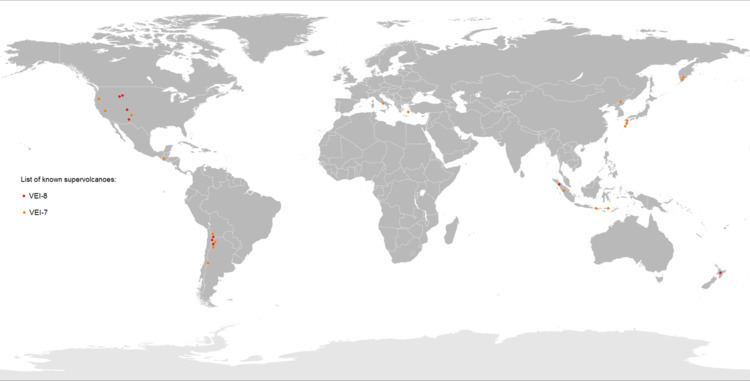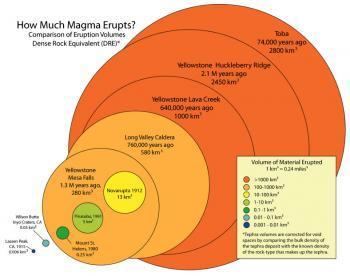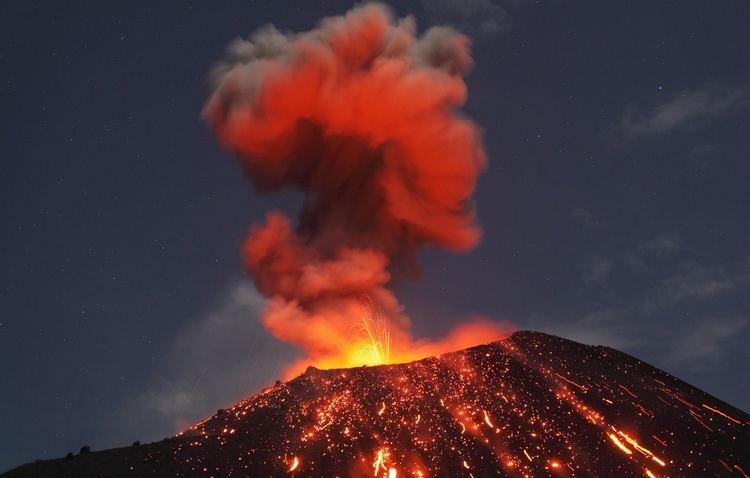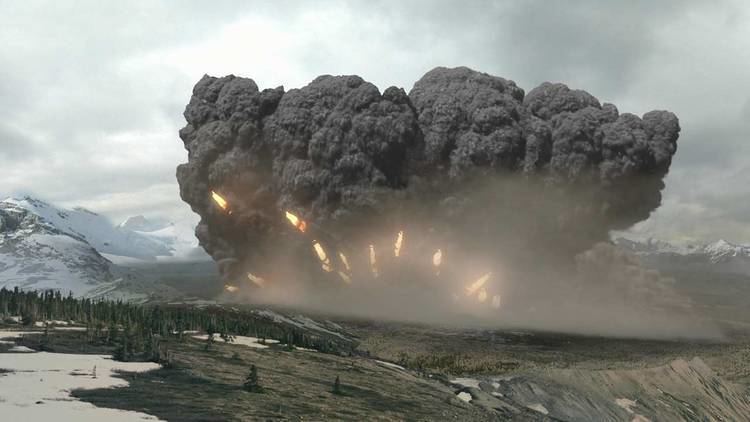 | ||
A supervolcano is a volcano capable of producing a volcanic eruption with an ejecta mass greater than 1015 kg (1012 t). Supervolcanoes occur when magma in the mantle rises into the crust but is unable to break through it and pressure builds in a large and growing magma pool until the crust is unable to contain the pressure. This can occur at hotspots (for example, Yellowstone Caldera) or at subduction zones (for example, Toba). Another setting for the eruption of very large amounts of volcanic material is in large igneous provinces, which can cover huge areas with lava and volcanic ash, causing long-lasting climate change (such as the triggering of a small ice age or global warming), which can threaten species with extinction. The Oruanui eruption of New Zealand's Taupo Volcano, the world's most recent supereruption, had a Volcanic Explosivity Index of 8.
Contents

Terminology

The origin of the term supervolcano is linked to an early 20th-century scientific debate about the geological history and features of the Three Sisters volcanic region of Oregon in the United States. In 1925, Edwin T. Hodge suggested that a very large volcano, which he named Mount Multnomah, had existed in that region. He believed that several peaks in the Three Sisters area are the remnants left after Mount Multnomah had been largely destroyed by violent volcanic explosions, similar to Mount Mazama. In 1948, the possible existence of Mount Multnomah was ignored by volcanologist Howel Williams in his book The Ancient Volcanoes of Oregon. The book was reviewed in 1949 by another volcanologist, F. M. Byers Jr. In the review, Byers refers to Mount Multnomah as a supervolcano. Although Hodge's suggestion that Mount Multnomah is a supervolcano was rejected long ago, the term supervolcano was popularised by the BBC popular science television program Horizon in 2000 to refer to eruptions that produce extremely large amounts of ejecta.

Volcanologists and geologists do not refer to "supervolcanoes" in their scientific work, since this is a blanket term that can be applied to a number of different geological settings. Since about 2000, however, the term has been used by professionals for communicating science to the public. The term megacaldera is sometimes used for caldera supervolcanoes, such as the Blake River Megacaldera Complex in the Abitibi greenstone belt of Ontario and Quebec, Canada. Eruptions that rate VEI 8 are termed super eruptions. Though there is no well-defined minimum explosive size for a "supervolcano", there are at least two types of volcanic eruptions that have been identified as supervolcanoes: large igneous provinces and massive eruptions.
Large igneous provinces
Large igneous provinces (LIP) such as Iceland, the Siberian Traps, Deccan Traps, and the Ontong Java Plateau are extensive regions of basalts on a continental scale resulting from flood basalt eruptions. When created, these regions often occupy several thousand square kilometres and have volumes on the order of millions of cubic kilometers. In most cases, the lavas are normally laid down over several million years. They release large amounts of gases. The Réunion hotspot produced the Deccan Traps about 66 million years ago, coincident with the Cretaceous–Paleogene extinction event. The scientific consensus is that a meteor impact was the cause of the extinction event, but the volcanic activity may have caused environmental stresses on extant species up to the Cretaceous–Paleogene boundary. Additionally, the largest flood basalt event (the Siberian Traps) occurred around 250 million years ago and was coincident with the largest mass extinction in history, the Permian–Triassic extinction event, although it is also unknown whether it was completely responsible for the extinction event.
Such outpourings are not explosive, though lava fountains may occur. Many volcanologists consider that Iceland may be a LIP that is currently being formed. The last major outpouring occurred in 1783–84 from the Laki fissure which is approximately 40 km (25 mi) long. An estimated 14 km3 (3.4 cu mi) of basaltic lava was poured out during the eruption.
The Ontong Java Plateau now has an area of about 2,000,000 km2 (770,000 sq mi), and the province was at least 50% larger before the Manihiki and Hikurangi Plateaus broke away.
Massive explosive eruptions
Volcanic eruptions are classified using the Volcanic Explosivity Index, or VEI. It is a logarithmic scale, which means that an increase of one in VEI number is equivalent to a tenfold increase in volume of erupted material. VEI 7 or VEI 8 eruptions are so powerful that they often form circular calderas rather than cones because the downward withdrawal of magma causes the overlying rock mass to collapse into the empty magma chamber beneath it.
VEI 8 eruptions are colossal events that throw out at least 1,000 km3 (240 cu mi) bulk volume.
VEI 7 events eject bulk volume at least 100 km3 (24 cu mi).
VEI 6 eruptions occurred at Krakatoa in 1883 and Mount Pinatubo in 1991. These eruptions ejected ~10 and 25 km3 (2.4 and 6.0 cu mi) bulk volume, respectively. At Krakatoa, the Dutch colonial authorities claimed that the death toll was 36,417, but other estimates consider that the death toll is in excess of 120,000.
The 1980 Mount St. Helens eruption was a VEI 5 eruption, with 1.2 km3 (0.29 cu mi) bulk volume of ejecta.
VEI 8
Based on incomplete statistics, at least 60 VEI 8 eruptions have been identified.
VEI 7
VEI 7 eruptions, less colossal but still supermassive, have occurred in historical times. The only ones in the past 2,000 years are Tambora, in 1815, Taupo Volcano's Hatepe eruption, c. 232, Baekdu Mountain, in 946–47, and the eruption of Mount Samalas in 1257.
* means DRE (dense rock equivalent).
